oil change FORD F650 2006 11.G Owners Manual
[x] Cancel search | Manufacturer: FORD, Model Year: 2006, Model line: F650, Model: FORD F650 2006 11.GPages: 272, PDF Size: 1.86 MB
Page 3 of 272
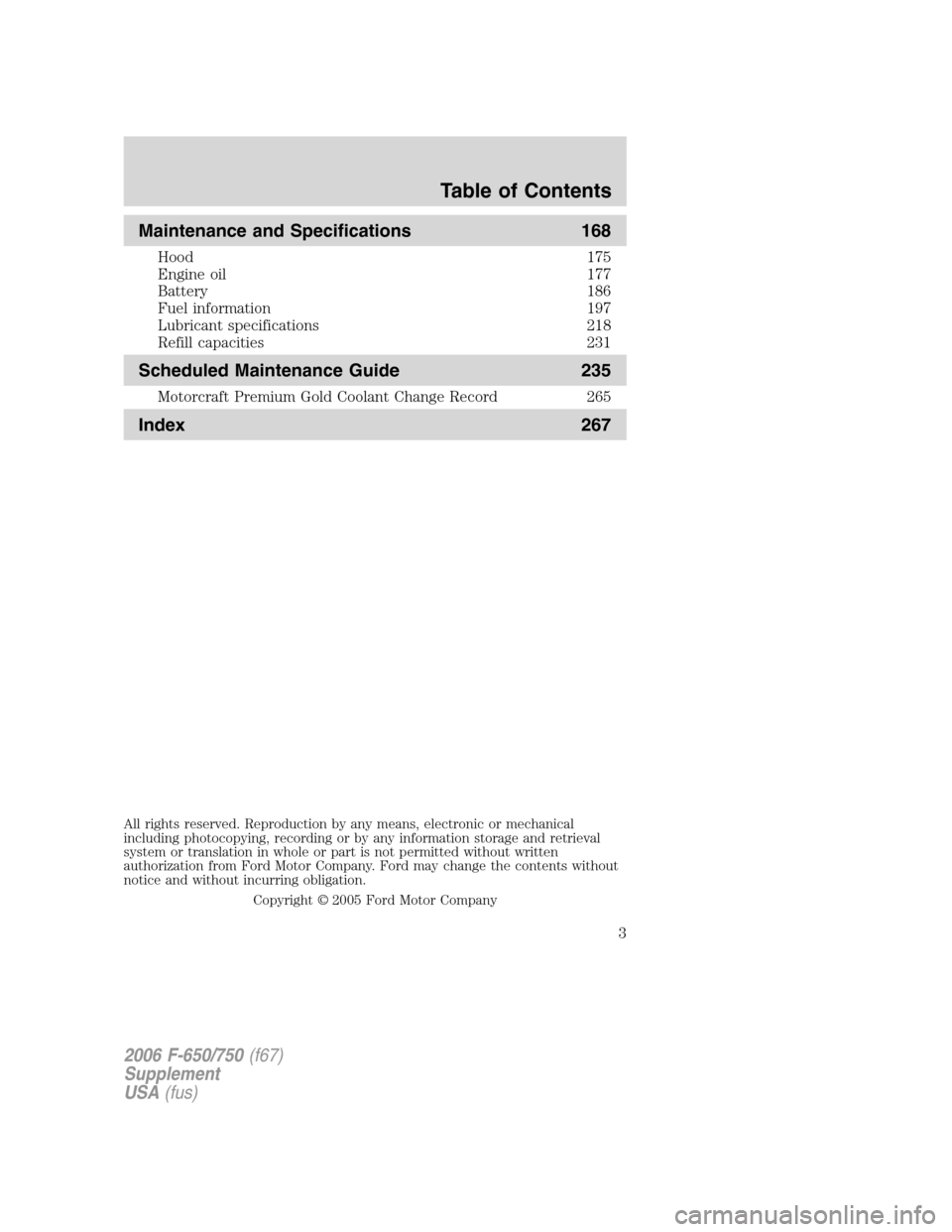
Maintenance and Specifications 168
Hood 175
Engine oil 177
Battery 186
Fuel information 197
Lubricant specifications 218
Refill capacities 231
Scheduled Maintenance Guide 235
Motorcraft Premium Gold Coolant Change Record 265
Index 267
All rights reserved. Reproduction by any means, electronic or mechanical
including photocopying, recording or by any information storage and retrieval
system or translation in whole or part is not permitted without written
authorization from Ford Motor Company. Ford may change the contents without
notice and without incurring obligation.
Copyright © 2005 Ford Motor Company
Table of Contents
3
2006 F-650/750(f67)
Supplement
USA(fus)
Page 18 of 272
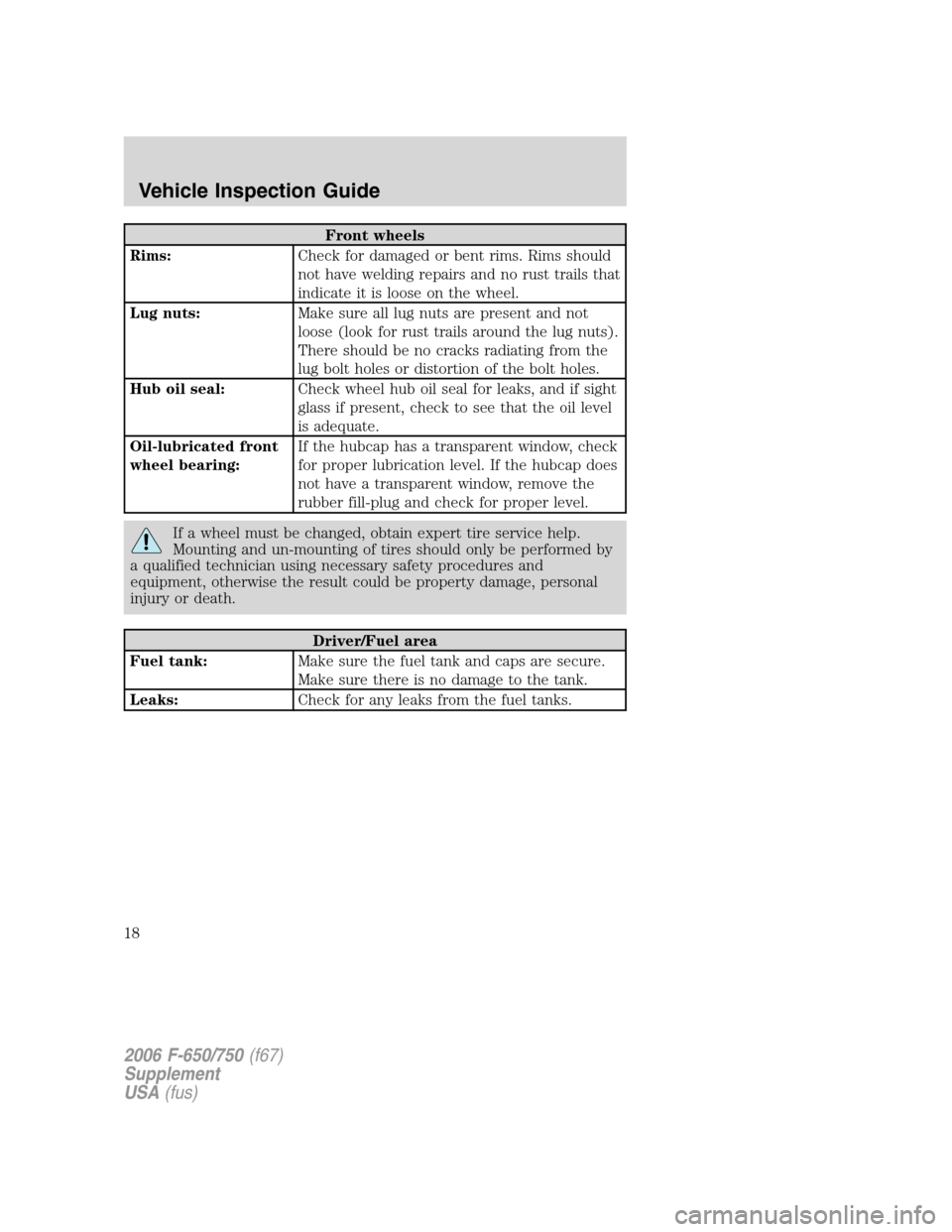
Front wheels
Rims:Check for damaged or bent rims. Rims should
not have welding repairs and no rust trails that
indicate it is loose on the wheel.
Lug nuts:Make sure all lug nuts are present and not
loose (look for rust trails around the lug nuts).
There should be no cracks radiating from the
lug bolt holes or distortion of the bolt holes.
Hub oil seal:Check wheel hub oil seal for leaks, and if sight
glass if present, check to see that the oil level
is adequate.
Oil-lubricated front
wheel bearing:If the hubcap has a transparent window, check
for proper lubrication level. If the hubcap does
not have a transparent window, remove the
rubber fill-plug and check for proper level.
If a wheel must be changed, obtain expert tire service help.
Mounting and un-mounting of tires should only be performed by
a qualified technician using necessary safety procedures and
equipment, otherwise the result could be property damage, personal
injury or death.
Driver/Fuel area
Fuel tank:Make sure the fuel tank and caps are secure.
Make sure there is no damage to the tank.
Leaks:Check for any leaks from the fuel tanks.
2006 F-650/750(f67)
Supplement
USA(fus)
Vehicle Inspection Guide
18
Page 178 of 272
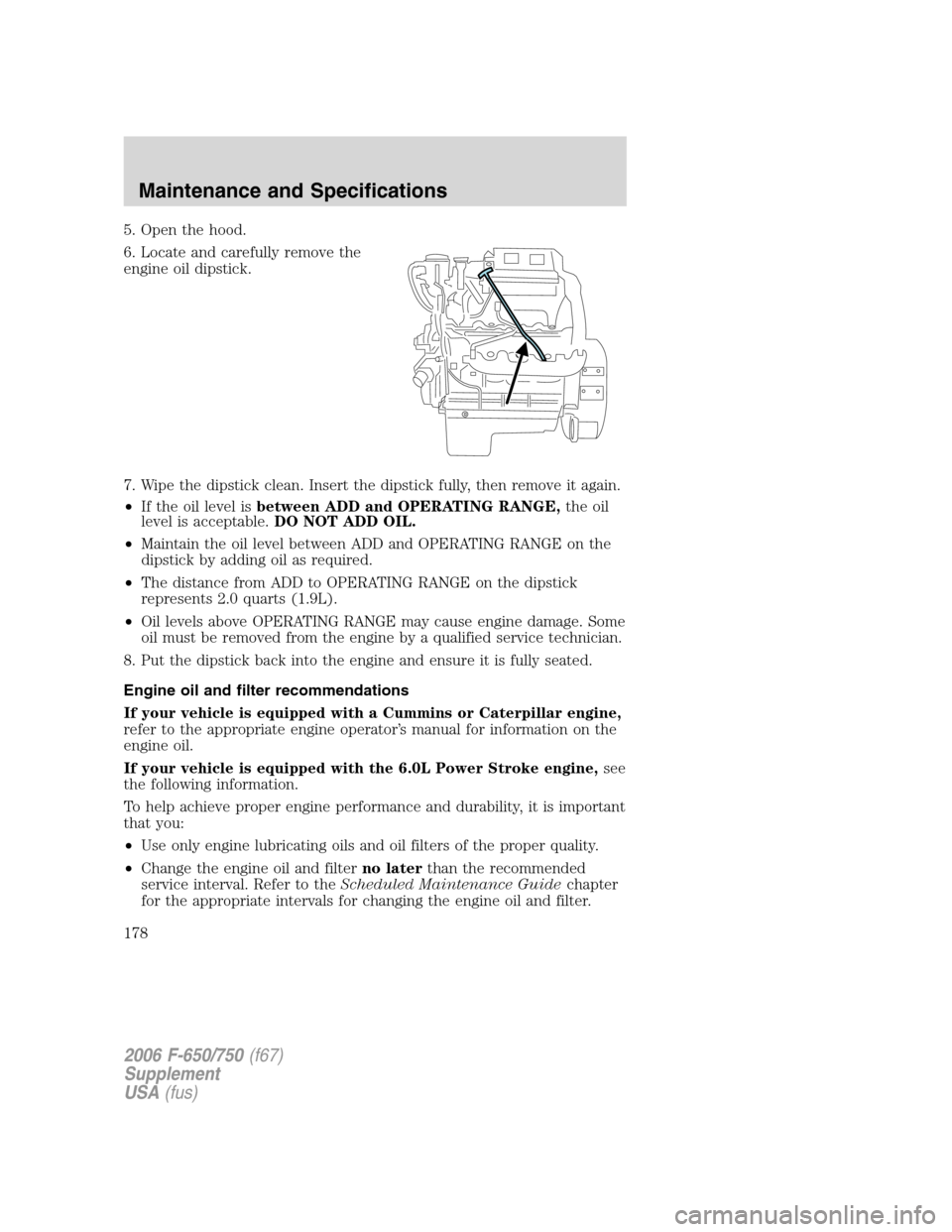
5. Open the hood.
6. Locate and carefully remove the
engine oil dipstick.
7. Wipe the dipstick clean. Insert the dipstick fully, then remove it again.
•If the oil level isbetween ADD and OPERATING RANGE,the oil
level is acceptable.DO NOT ADD OIL.
•Maintain the oil level between ADD and OPERATING RANGE on the
dipstick by adding oil as required.
•The distance from ADD to OPERATING RANGE on the dipstick
represents 2.0 quarts (1.9L).
•Oil levels above OPERATING RANGE may cause engine damage. Some
oil must be removed from the engine by a qualified service technician.
8. Put the dipstick back into the engine and ensure it is fully seated.
Engine oil and filter recommendations
If your vehicle is equipped with a Cummins or Caterpillar engine,
refer to the appropriate engine operator’s manual for information on the
engine oil.
If your vehicle is equipped with the 6.0L Power Stroke engine,see
the following information.
To help achieve proper engine performance and durability, it is important
that you:
•Use only engine lubricating oils and oil filters of the proper quality.
•Change the engine oil and filterno laterthan the recommended
service interval. Refer to theScheduled Maintenance Guidechapter
for the appropriate intervals for changing the engine oil and filter.
2006 F-650/750(f67)
Supplement
USA(fus)
Maintenance and Specifications
178
Page 179 of 272
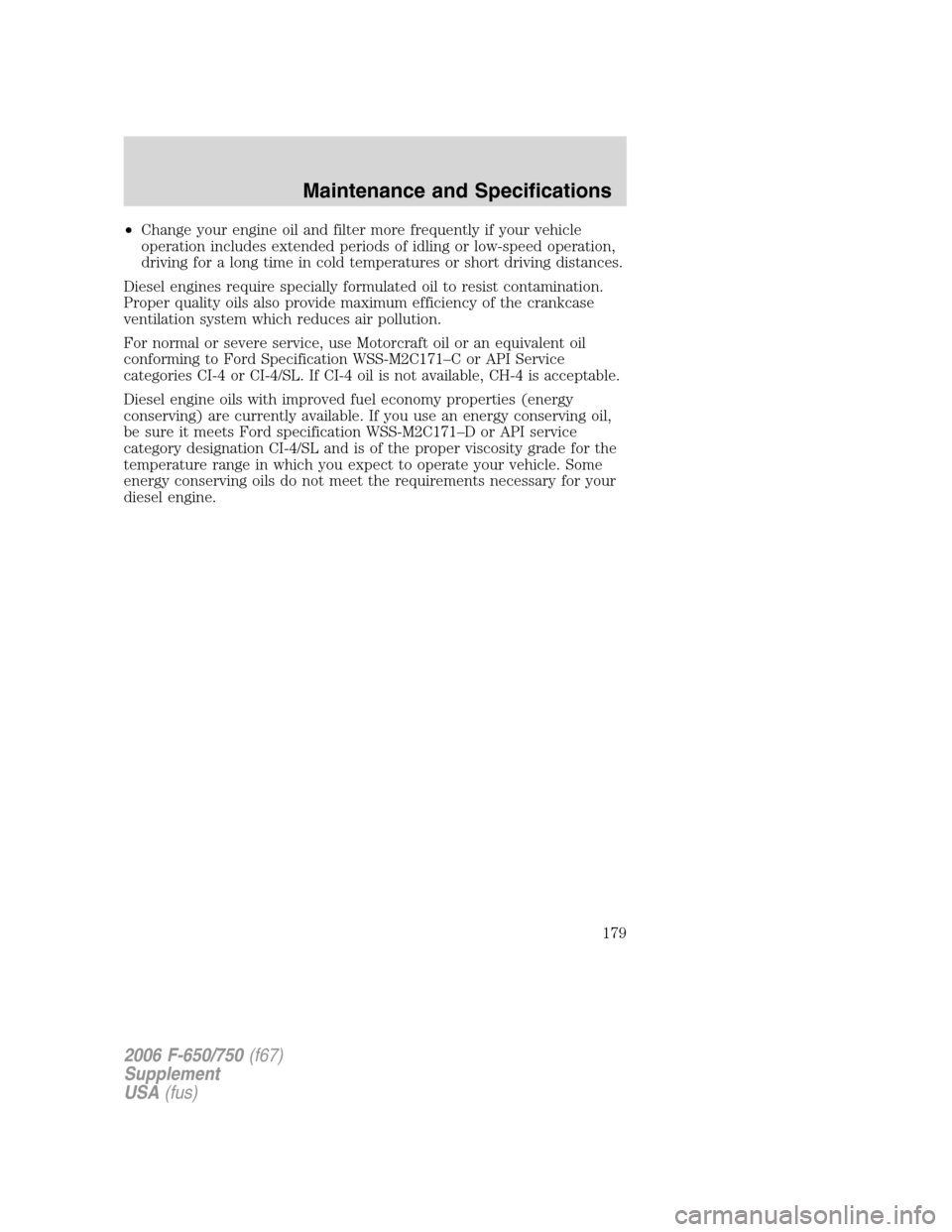
•Change your engine oil and filter more frequently if your vehicle
operation includes extended periods of idling or low-speed operation,
driving for a long time in cold temperatures or short driving distances.
Diesel engines require specially formulated oil to resist contamination.
Proper quality oils also provide maximum efficiency of the crankcase
ventilation system which reduces air pollution.
For normal or severe service, use Motorcraft oil or an equivalent oil
conforming to Ford Specification WSS-M2C171–C or API Service
categories CI-4 or CI-4/SL. If CI-4 oil is not available, CH-4 is acceptable.
Diesel engine oils with improved fuel economy properties (energy
conserving) are currently available. If you use an energy conserving oil,
be sure it meets Ford specification WSS-M2C171–D or API service
category designation CI-4/SL and is of the proper viscosity grade for the
temperature range in which you expect to operate your vehicle. Some
energy conserving oils do not meet the requirements necessary for your
diesel engine.
2006 F-650/750(f67)
Supplement
USA(fus)
Maintenance and Specifications
179
Page 203 of 272
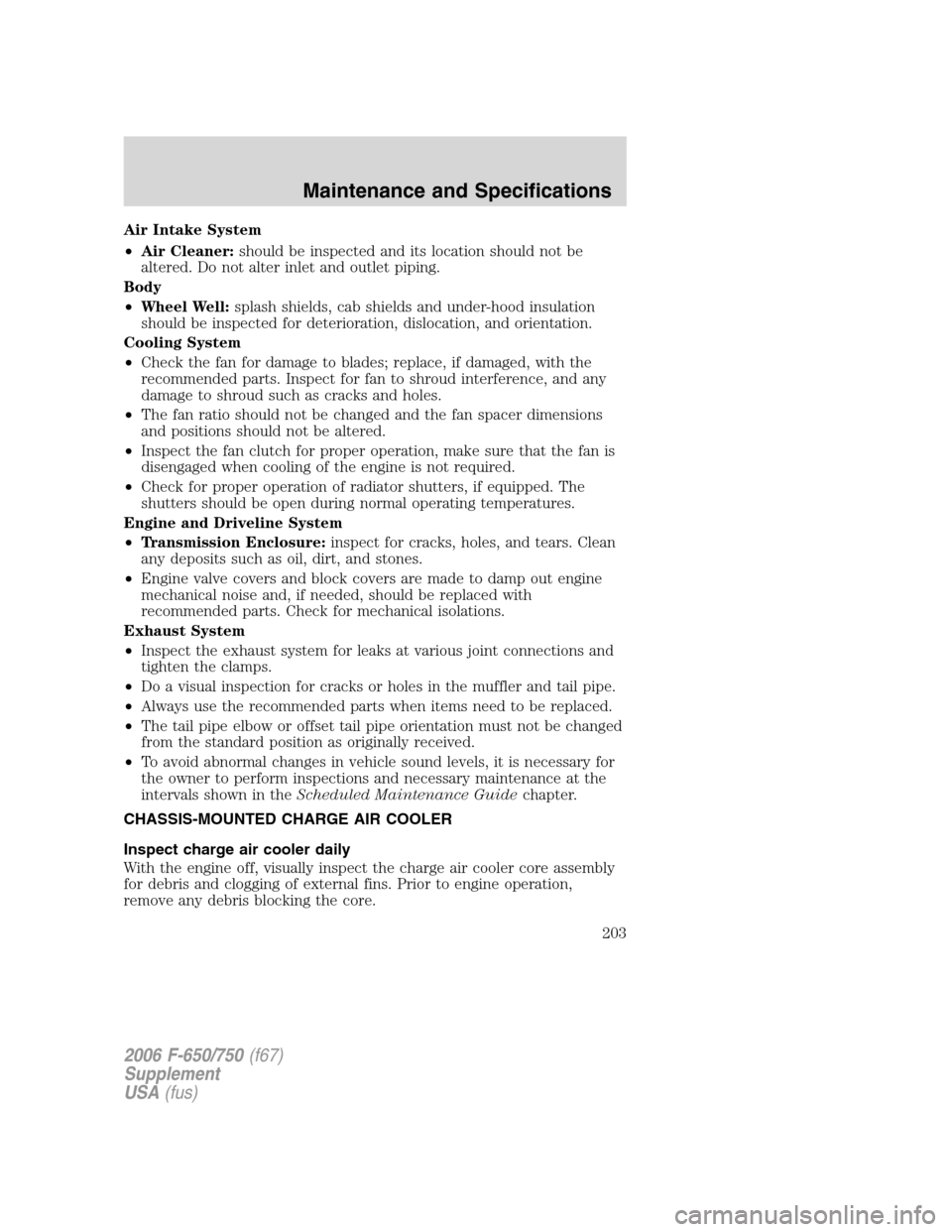
Air Intake System
•Air Cleaner:should be inspected and its location should not be
altered. Do not alter inlet and outlet piping.
Body
•Wheel Well:splash shields, cab shields and under-hood insulation
should be inspected for deterioration, dislocation, and orientation.
Cooling System
•Check the fan for damage to blades; replace, if damaged, with the
recommended parts. Inspect for fan to shroud interference, and any
damage to shroud such as cracks and holes.
•The fan ratio should not be changed and the fan spacer dimensions
and positions should not be altered.
•Inspect the fan clutch for proper operation, make sure that the fan is
disengaged when cooling of the engine is not required.
•Check for proper operation of radiator shutters, if equipped. The
shutters should be open during normal operating temperatures.
Engine and Driveline System
•Transmission Enclosure:inspect for cracks, holes, and tears. Clean
any deposits such as oil, dirt, and stones.
•Engine valve covers and block covers are made to damp out engine
mechanical noise and, if needed, should be replaced with
recommended parts. Check for mechanical isolations.
Exhaust System
•Inspect the exhaust system for leaks at various joint connections and
tighten the clamps.
•Do a visual inspection for cracks or holes in the muffler and tail pipe.
•Always use the recommended parts when items need to be replaced.
•The tail pipe elbow or offset tail pipe orientation must not be changed
from the standard position as originally received.
•To avoid abnormal changes in vehicle sound levels, it is necessary for
the owner to perform inspections and necessary maintenance at the
intervals shown in theScheduled Maintenance Guidechapter.
CHASSIS-MOUNTED CHARGE AIR COOLER
Inspect charge air cooler daily
With the engine off, visually inspect the charge air cooler core assembly
for debris and clogging of external fins. Prior to engine operation,
remove any debris blocking the core.
2006 F-650/750(f67)
Supplement
USA(fus)
Maintenance and Specifications
203
Page 205 of 272
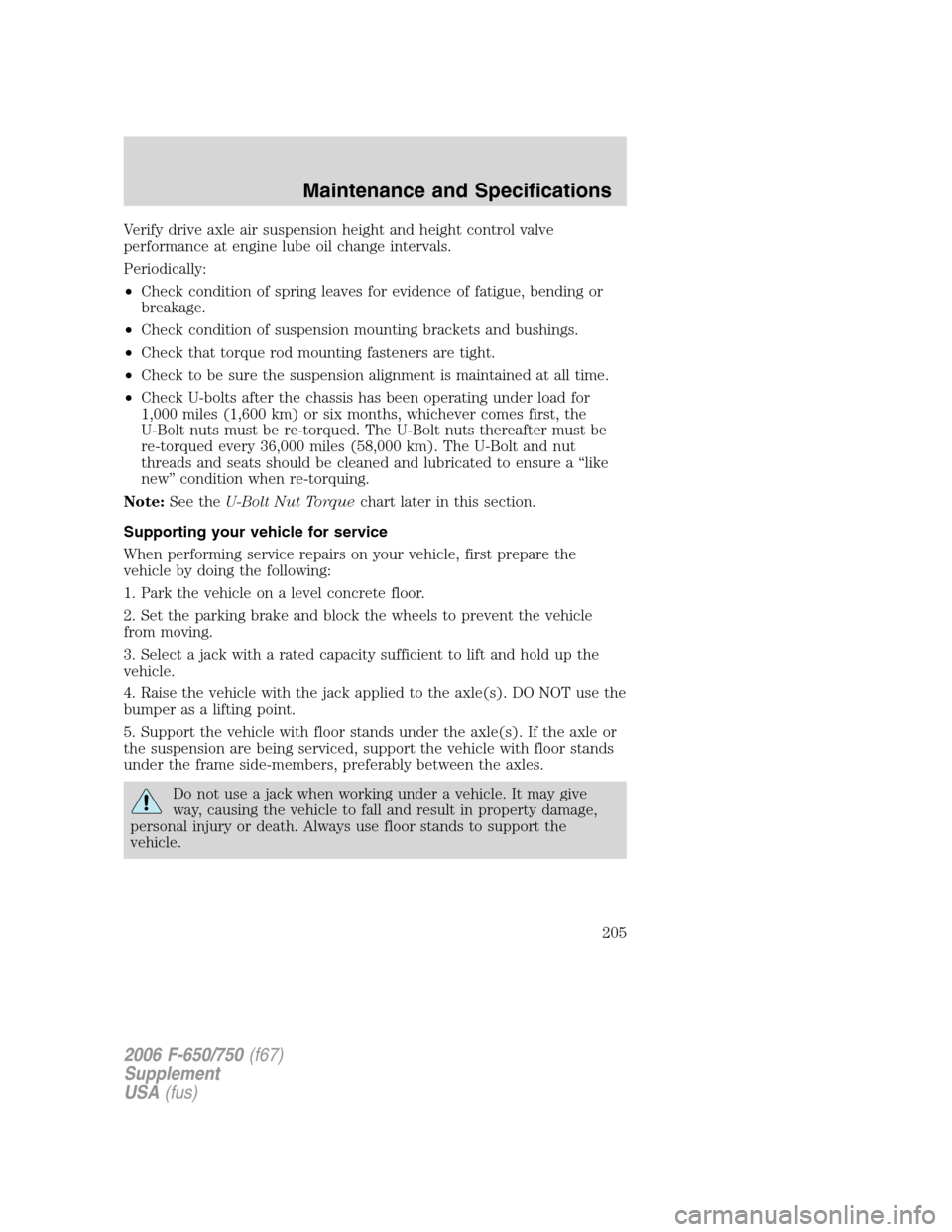
Verify drive axle air suspension height and height control valve
performance at engine lube oil change intervals.
Periodically:
•Check condition of spring leaves for evidence of fatigue, bending or
breakage.
•Check condition of suspension mounting brackets and bushings.
•Check that torque rod mounting fasteners are tight.
•Check to be sure the suspension alignment is maintained at all time.
•Check U-bolts after the chassis has been operating under load for
1,000 miles (1,600 km) or six months, whichever comes first, the
U-Bolt nuts must be re-torqued. The U-Bolt nuts thereafter must be
re-torqued every 36,000 miles (58,000 km). The U-Bolt and nut
threads and seats should be cleaned and lubricated to ensure a “like
new” condition when re-torquing.
Note:See theU-Bolt Nut Torquechart later in this section.
Supporting your vehicle for service
When performing service repairs on your vehicle, first prepare the
vehicle by doing the following:
1. Park the vehicle on a level concrete floor.
2. Set the parking brake and block the wheels to prevent the vehicle
from moving.
3. Select a jack with a rated capacity sufficient to lift and hold up the
vehicle.
4. Raise the vehicle with the jack applied to the axle(s). DO NOT use the
bumper as a lifting point.
5. Support the vehicle with floor stands under the axle(s). If the axle or
the suspension are being serviced, support the vehicle with floor stands
under the frame side-members, preferably between the axles.
Do not use a jack when working under a vehicle. It may give
way, causing the vehicle to fall and result in property damage,
personal injury or death. Always use floor stands to support the
vehicle.
2006 F-650/750(f67)
Supplement
USA(fus)
Maintenance and Specifications
205
Page 239 of 272
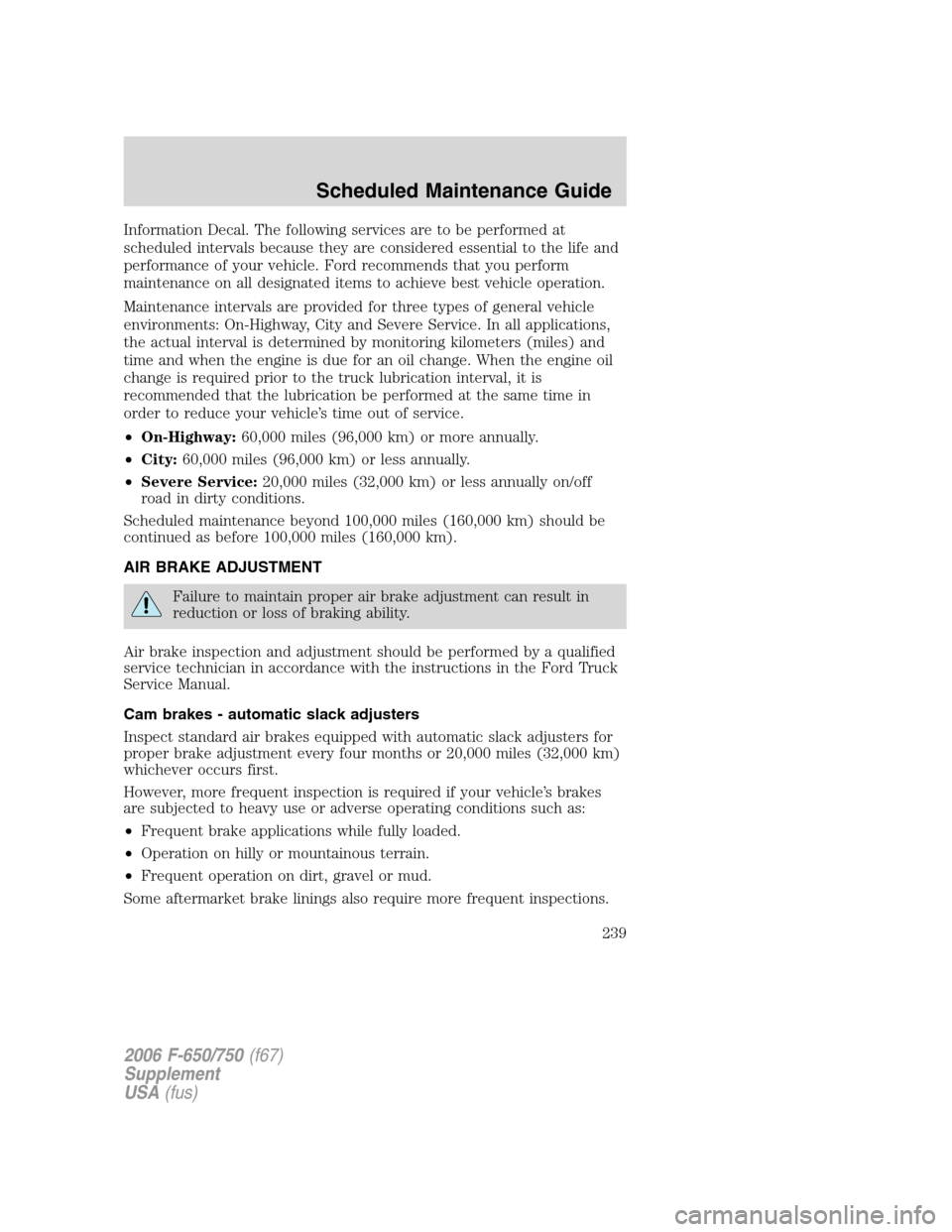
Information Decal. The following services are to be performed at
scheduled intervals because they are considered essential to the life and
performance of your vehicle. Ford recommends that you perform
maintenance on all designated items to achieve best vehicle operation.
Maintenance intervals are provided for three types of general vehicle
environments: On-Highway, City and Severe Service. In all applications,
the actual interval is determined by monitoring kilometers (miles) and
time and when the engine is due for an oil change. When the engine oil
change is required prior to the truck lubrication interval, it is
recommended that the lubrication be performed at the same time in
order to reduce your vehicle’s time out of service.
•On-Highway:60,000 miles (96,000 km) or more annually.
•City:60,000 miles (96,000 km) or less annually.
•Severe Service:20,000 miles (32,000 km) or less annually on/off
road in dirty conditions.
Scheduled maintenance beyond 100,000 miles (160,000 km) should be
continued as before 100,000 miles (160,000 km).
AIR BRAKE ADJUSTMENT
Failure to maintain proper air brake adjustment can result in
reduction or loss of braking ability.
Air brake inspection and adjustment should be performed by a qualified
service technician in accordance with the instructions in the Ford Truck
Service Manual.
Cam brakes - automatic slack adjusters
Inspect standard air brakes equipped with automatic slack adjusters for
proper brake adjustment every four months or 20,000 miles (32,000 km)
whichever occurs first.
However, more frequent inspection is required if your vehicle’s brakes
are subjected to heavy use or adverse operating conditions such as:
•Frequent brake applications while fully loaded.
•Operation on hilly or mountainous terrain.
•Frequent operation on dirt, gravel or mud.
Some aftermarket brake linings also require more frequent inspections.
2006 F-650/750(f67)
Supplement
USA(fus)
Scheduled Maintenance Guide
239
Page 242 of 272
![FORD F650 2006 11.G Owners Manual Check every oil change (Oil change interval for the 6.0L Power
Stroke engine is 10,000 miles [16,000 km]; (refer to the
Caterpillar and Cummins service manuals for instructions and
information)
Engine FORD F650 2006 11.G Owners Manual Check every oil change (Oil change interval for the 6.0L Power
Stroke engine is 10,000 miles [16,000 km]; (refer to the
Caterpillar and Cummins service manuals for instructions and
information)
Engine](/img/11/5072/w960_5072-241.png)
Check every oil change (Oil change interval for the 6.0L Power
Stroke engine is 10,000 miles [16,000 km]; (refer to the
Caterpillar and Cummins service manuals for instructions and
information)
Engine systemCheck the engine cooling system -
hoses, clamps and protection*.
Inspect the drive belts.
Exhaust systemInspect the entire exhaust system
(including the inlet pipe(s),
muffler(s), outlet pipe(s), clamps and
fasteners) for holes, leakage,
breakage, corrosive damage and
separation from other components.
Adjust, service or replace with the
same or the equivalent part. (Also a
noise emission control service).
Suspension systemTighten the front and rear spring
U-bolts to the specified torque.
Driveline and rear axle
systemLubricate the U-joints and the slip
yoke.
Brake systemLube the air brake foot control valve,
hinge and roller.
Inspect the drum brake linings
through the inspection holes.
Lubricate the brake camshafts (air
brakes only).
Lubricate the brake slack adjuster (air
brakes only).
Lubricate rear caliper slide rails.
Inspect the disc brake pads and the
piston boots (hydraulic brakes only).
Clutch systemLubricate the clutch release cross
shaft and all linkages.
Check the clutch fluid.
2006 F-650/750(f67)
Supplement
USA(fus)
Scheduled Maintenance Guide
242
Page 243 of 272
![FORD F650 2006 11.G Owners Manual Check every oil change (Oil change interval for the 6.0L Power
Stroke engine is 10,000 miles [16,000 km]; (refer to the
Caterpillar and Cummins service manuals for instructions and
information)
Fuel s FORD F650 2006 11.G Owners Manual Check every oil change (Oil change interval for the 6.0L Power
Stroke engine is 10,000 miles [16,000 km]; (refer to the
Caterpillar and Cummins service manuals for instructions and
information)
Fuel s](/img/11/5072/w960_5072-242.png)
Check every oil change (Oil change interval for the 6.0L Power
Stroke engine is 10,000 miles [16,000 km]; (refer to the
Caterpillar and Cummins service manuals for instructions and
information)
Fuel systemDrain the accumulated water or
sediment from the fuel tank(s).
Steering systemLubricate the steering shaft(s),
U-joints and splines when equipped
with grease fittings.
Lubricate the front axle spindle pins.
Lubricate the steering linkage when
equipped with grease fittings.
Grease the power steering gear output
shaft.
* Coolant protection checks should be made just prior to the onset of
freezing weather, where applicable. If coolant is dirty or rusty in
appearance, the system should be drained, flushed and refilled with the
prescribed solution of cooling system fluid and water. Use only
permanent type coolant that meets Ford specifications
WSS-M97B51-A1. See the engine manufacturer’s operating guide for
supplemental corrosion inhibitor specifications.
In addition to the items to be performed daily or at each oil change, the
following need to be completed as specified:
GENERAL MAINTENANCE SERVICES
The following are vehicle checks that should be made periodically either
by the owner or a qualified technician. It is recommended that
deficiencies be brought to the attention of your dealer or another
qualified service outlet as soon as possible in order that advice regarding
the need for service or replacement can be obtained.
2006 F-650/750(f67)
Supplement
USA(fus)
Scheduled Maintenance Guide
243
Page 246 of 272
![FORD F650 2006 11.G Owners Manual ComponentOn-Highway (60,000 miles [96,000 km] or more annually) -
Miles, kilometers or months - whichever occurs first
Miles (x 1000) 15 30 45 60 75 90 105 120 135 150
Kilometers (x 1000) 24 48 72 96 FORD F650 2006 11.G Owners Manual ComponentOn-Highway (60,000 miles [96,000 km] or more annually) -
Miles, kilometers or months - whichever occurs first
Miles (x 1000) 15 30 45 60 75 90 105 120 135 150
Kilometers (x 1000) 24 48 72 96](/img/11/5072/w960_5072-245.png)
ComponentOn-Highway (60,000 miles [96,000 km] or more annually) -
Miles, kilometers or months - whichever occurs first
Miles (x 1000) 15 30 45 60 75 90 105 120 135 150
Kilometers (x 1000) 24 48 72 96 120 144 168 192 216 240
Months 3 6 9 12 15 18 21 24 27 30
Non-driving front axle
Wheel bearing - oil type - check level••••••••••
Wheel bearing - oil type - change oil•
Wheel bearing - grease type - repack•••••
Tie rod ends - lubricate••••••••••
Drag link - lubricate••••••••••
King pin and bushing - lubricate••••••••••
Brake system - air
Slack adjusters - lubricate••
S-cam - lubricate••••••••••
Brake system - hydraulic
Master cylinder - check level••••••••••
Park brake relay lever / linkage -
lubricate••
Steering
Power steering fluid - check level••••••••••
Power steering fluid - change fluid•
Power steering filter - replacement Five years or 500,000 miles (800,000 km)
Steering gear Ross TAS - output shaft -
lubricate•••
Steering column u-joints / slip joint -
lubricate••••••••••
Propeller shaft SPL
U-joint - lubricate•••••
Propeller shaft non-SPL
U-joint and slip joint - lubricate••••••••••
Clutch
Release bearing / shafts / forks -
lubricate••••••••••
2006 F-650/750(f67)
Supplement
USA(fus)
Scheduled Maintenance Guide
246